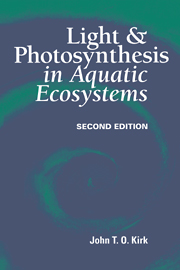Book contents
- Frontmatter
- Contents
- Preface to the first edition
- Preface to the second edition
- Part I The underwater light field
- Part II Photosynthesis in the aquatic environment
- 8 The photosynthetic apparatus of aquatic plants
- 9 Light capture by aquatic plants
- 10 Photosynthesis as a function of the incident light
- 11 Photosynthesis in the aquatic environment
- 12 Ecological strategies
- References and author index
- Index to symbols
- Index to organisms
- Index to water bodies
- Subject index
11 - Photosynthesis in the aquatic environment
Published online by Cambridge University Press: 25 January 2010
- Frontmatter
- Contents
- Preface to the first edition
- Preface to the second edition
- Part I The underwater light field
- Part II Photosynthesis in the aquatic environment
- 8 The photosynthetic apparatus of aquatic plants
- 9 Light capture by aquatic plants
- 10 Photosynthesis as a function of the incident light
- 11 Photosynthesis in the aquatic environment
- 12 Ecological strategies
- References and author index
- Index to symbols
- Index to organisms
- Index to water bodies
- Subject index
Summary
Having considered the photosynthetic response of aquatic plants to light of different intensities and spectral qualities, we shall now examine how the availability of light influences where, when and how much photosynthesis takes place in aquatic ecosystems, and also the extent to which other parameters of the environment can limit photosynthesis. Aquatic production ecology is an enormous field: a comprehensive account will not therefore be attempted. Rather, the broad principles governing the controlling influence of light and other parameters will be outlined and illustrated by examples. More detailed accounts and extensive bibliographies can be found in the books on phytoplankton ecology by Reynolds (1984), Harris (1986) and Fogg & Thake (1987), and the symposium proceedings edited by Platt & Li (1986) and Falkowski & Woodhead (1992). The essay by Fogg (1991) on ‘The phytoplanktonic way of life’ provides a particularly valuable overview of the multifarious interactions between the phytopl ankton and its environment.
Circulation and depth
We saw in the previous chapter that except under very still conditions with virtually no wind or waves, there is always circulation of water in the upper layer. We also saw that this can be an advantage to the phytoplankton insofar as, by ensuring that they are not exposed to the intense light just below the surface for very long, they avoid photoinhibition. This circulation can, however, also be a disadvantage to the phytoplankton if, in the lower reaches of the mixed layer, the light intensity is too low for net photosynthesis to be achieved.
- Type
- Chapter
- Information
- Light and Photosynthesis in Aquatic Ecosystems , pp. 314 - 359Publisher: Cambridge University PressPrint publication year: 1994
- 6
- Cited by



